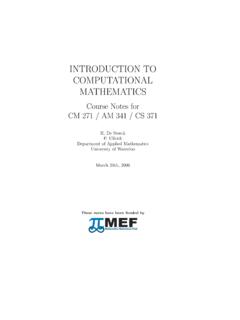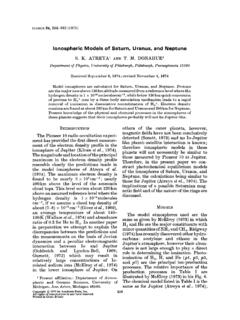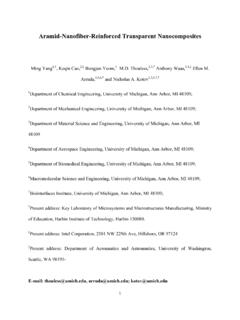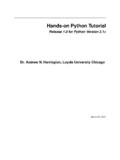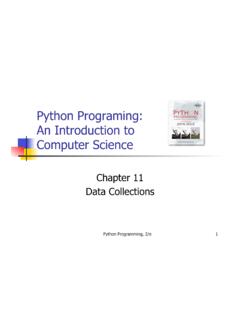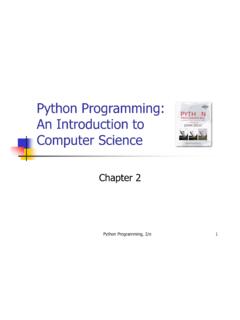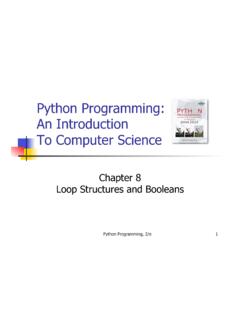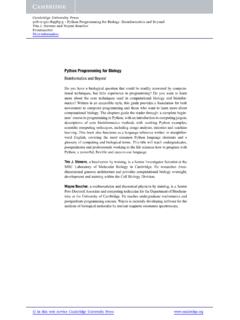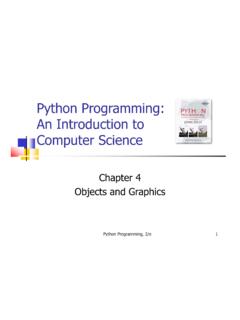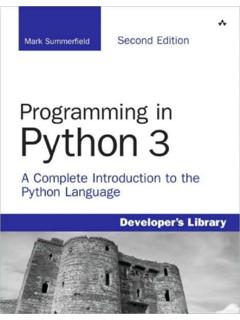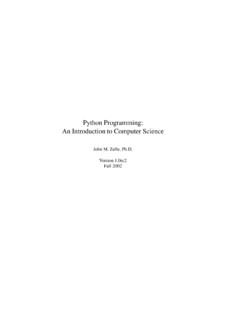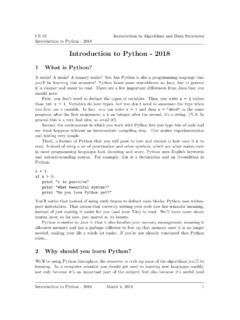Transcription of PYTHON PROGRAMMING FOR PHYSICISTS - U-M Personal …
1 CHAPTER2 PYTHON PROGRAMMING FOR PHYSICISTSOUR FIRST item of business is to learn how to write computer programs inthe PYTHON PROGRAMMING is easy to learn, simple to use, and enormously powerful. It hasfacilities and features for performing tasks of many can do art orengineering in PYTHON , surf the web or calculate your taxes,write words orwrite music, make a movie or make the next billion-dollar Internet will not attempt to learn about all of PYTHON s features, however, but restrictourselves to those that are most useful for doing physics calculations. We willlearn about the core structure of the language first, how to put together theinstructions that make up a program, but we will also learn about some of thepowerful features that can make the life of a computational physicist easier,such as features for doing calculations with vectors and matrices, and featuresfor making graphs and computer graphics.
2 Some other features of Pythonthat are more specialized, but still occasionally useful for PHYSICISTS , will notbe covered here. Luckily there is excellent documentation available on-line,so if there s something you want to do and it s not explained in this book, Iencourage you to see what you can find. A good place to start when lookingfor information about PYTHON is the official PYTHON website GETTING STARTEDA PYTHON program consists of a list of instructions, resembling a mixture ofEnglish words and mathematics and collectively referred toascode. We ll seeexactly what form the instructions take in a moment, but firstwe need to knowhow and where to enter them into the of these also require that you have a good | PYTHON PROGRAMMING FOR PHYSICISTSWhen you are PROGRAMMING in PYTHON developing a program, as the jar-gon goes you typically work in adevelopment environment, which is a windowor windows on your computer screen that show the program you are workingon and allow you to enter or edit lines of code.
3 There are several differentdevelopment environments available for use with PYTHON , but the most com-monly used is the one called you have PYTHON installed on your com-puter then you probably have IDLE installed as well. (If not, itis available as afree download from the ) How you start IDLE depends on what kind ofcomputer you have, but most commonly you click on an icon on the desktopor under the start menu on a PC, or in the dock or the applications folder ona Mac. If you wish, you can now start IDLE running on your computer andfollow along with the developments in this chapter step by first thing that happens when you start IDLE is that a windowappearson the computer screen. This is thePython shell window. It will have some textin it, looking something like this: PYTHON (default, Sep 29 2012)Type "help" for more information.>>>This tells you what version of PYTHON you are running (your version may bedifferent from the one above), along with some other information, followed bythe symbol >>> , which is a prompt: it tells you that the computer is readyfor you to type something in.
4 When you see this prompt you can type anycommand in the PYTHON language at the keyboard and the computer will carryout that command immediately. This can be a useful way to quickly try in-dividual PYTHON commands when you re not sure how somethingworks, butit s not the main way that we will use PYTHON commands. Normally, we wantto type in an entire PYTHON program at once, consisting of many commandsone after another, then run the whole program together. To dothis, go to thetop of the window, where you will see a set of menu headings. Click on the File menu and select New Window . This will create a second window on2 IDLE stands for Integrated Development Environment (sort of). The name is also a joke, thePython language itself being named, allegedly, after the influential British comedy troupeMontyPython, one of whose members was the comedian Eric standard versions of PYTHON for PC and Mac computers come with IDLE.
5 For Linux users,IDLE does not usually come installed automatically, so you may haveto install it yourself. Themost widely used brands of Linux, including Ubuntu and Fedora, have freely available versionsof IDLE that can be installed using their built-in software installer |GETTING STARTEDthe screen, this one completely empty. This is aneditor window. It behaves dif-ferently from the PYTHON shell window. You type a complete program into thiswindow, usually consisting of many lines. You can edit it, add things, deletethings, cut, paste, and so forth, in a manner similar to the way one works witha word processor. The menus at the top of the window provide a range ofword-processor style features, such as cut and paste, and when you are fin-ished writing your program you can save your work just as you would witha word processor document. Then you can run your complete program, thewhole thing, by clicking on the Run menu at the top of the editor windowand selecting Run Module (or you can press the F5 function key, which isquicker).
6 This is the main way in which we will use PYTHON and IDLE in get the hang of how it works, try the following quick exercise. Openup an editor window if you didn t already (by selecting New Window fromthe File menu) and type the following (useless) two-line program into thewindow, just as it appears here:x = 1print(x)(If it s not obvious what this does, it will be soon.) Now save your programby selecting Save from the File menu at the top of the editor window andtyping in a names of all PYTHON programs must end with .py , soa suitable name might be or something like that. (If you do notgive your program a name ending in .py then the computer will not knowthat it is a PYTHON program and will not handle it properly when you try toload it again you will probably find that such a program will not even run atall, so the .py is important.)Once you have saved your program, run it by selecting Run module fromthe Run menu.
7 When you do this the program will start running, and anyoutput it produces anything it says or does or prints out willappear in thePython shell window (the other window, the one that appearedfirst). In this4 Note that you can have several windows open at once, includingthe PYTHON shell windowand one or more editor windows, and that each window has its own File menu with its own Save item. When you click on one of these to save, IDLE saves the contents of the specificwindow you clicked on. Thus if you want to save a program you must be careful to click on the File menu in the window containing the program, rather than in any other window. If you clickon the menu in the shell window, for instance, IDLE will save the contents of the shell window,not your program, which is probably not what you | PYTHON PROGRAMMING FOR PHYSICISTS case you should see something like this in the PYTHON shell window:1>>>The only result of this small program is that the computer prints out the num-ber 1 on the screen.
8 (It s the value of the variablexin the program seeSection below.) The number is followed by a prompt >>> again, whichtells you that the computer is done running your program and is ready to dosomething same procedure is the one you ll use for running all yourprogramsand you ll get used to it soon. It s a good idea to save your programs, as here,when they re finished and ready to run. If you forget to do it, IDLE will askyou if you want to save before it runs your is by no means the only development environment for PYTHON . If youare comfortable with computers and enjoy trying things out, there are a widerange of others available on the Internet, mostly for free, with names like Py-Dev, Eric, BlackAdder, Komodo, Wing, and more. Feel free to experiment andsee what works for you, or you can just stick with IDLE. IDLE can doevery-thing we ll need for the material in this book. But nothing inthe book willdepend on what development environment you use.
9 As far as theprogram-ming and the physics go, they are all BASIC PROGRAMMINGA program is a list of instructions, orstatements, which under normal circum-stances the computer carries out, orexecutes, in the order they appear in theprogram. Individual statements do things like performing arithmetic, askingfor input from the user of the program, or printing out results. The followingsections introduce the various types of statements in the PYTHON language oneby VARIABLES AND ASSIGNMENTSQ uantities of interest in a program which in physics usuallymeans numbers,or sets of numbers like vectors or matrices are represented byvariables, whichplay roughly the same role as they do in ordinary algebra. Ourfirst exampleof a program statement in PYTHON is this:x = |BASIC PROGRAMMINGThis is anassignment statement. It tells the computer that there is a variablecalledxand we are assigning it the value 1. You can think of the variable asa box that stores a value for you, so that you can come back and retrieve thatvalue at any later time, or change it to a different value.
10 We will use variablesextensively in our computer programs to represent physicalquantities like po-sitions, velocities, forces, fields, voltages, probabilities, and normal algebra variable names are usually just a single letter likex, butin PYTHON (and in most other PROGRAMMING languages) they don t have to be they can be two, three, or more letters, or entire words if youwant. Variablenames in PYTHON can be as long as you like and can contain both letters andnumbers, as well as the underscore symbol _ , but they cannot start with anumber, or contain any other symbols, or spaces. ThusxandPhysics_101are fine names for variables, but4 Score&7 Yearsis not (because it starts witha number, and also because it contains a&). Upper- and lower-case letters aredistinct from one another, meaning thatxandXare two different variableswhich can have different of the programs you will write will contain large numbers of vari-ables representing the values of different things and keeping them straight inyour head can be a challenge.




